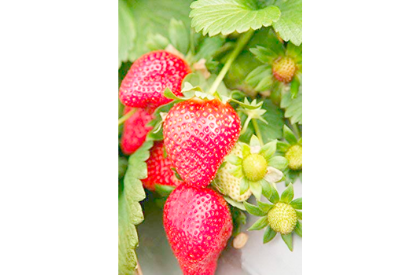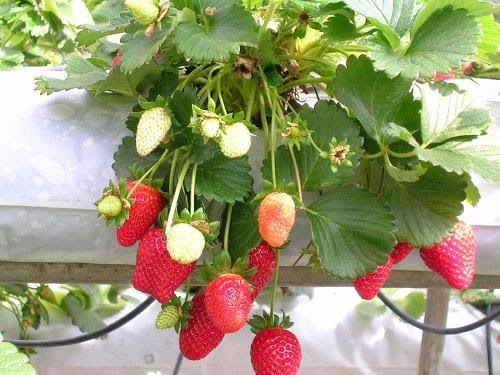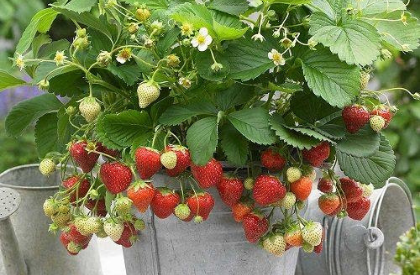Strawberries
What Is Vertical Farming?
Vertical farming is the practice of producing food on vertically inclined surfaces. Instead of farming vegetables and other foods on a single level, such as in a field or a greenhouse, this method produces foods in vertically stacked layers commonly integrated into other structures like a skyscraper, shipping container or repurposed warehouse.
Using Controlled Environment Agriculture (CEA) technology. The artificial control of temperature, light, humidity, and gases makes producing foods and medicine indoor possible. In many ways, vertical farming is similar to greenhouses where metal reflectors and artificial lighting augment natural sunlight. The primary goal of vertical farming is maximizing crops output in a limited space.
How Vertical Farming Works
There are four critical areas in understanding how vertical farming works: 1. Physical layout, 2. Lighting, 3. Growing medium, and 4. Sustainability features.
Firstly, the primary goal of vertical farming is producing more foods per square meter. To accomplish this goal, crops are cultivated in stacked layers in a tower life structure. Secondly, a perfect combination of natural and artificial lights is used to maintain the perfect light level in the room. Technologies such as rotating beds are used to improve lighting efficiency.
Thirdly, instead of soil, aeroponic, aquaponic or hydroponic growing mediums are used. Peat moss or coconut husks and similar non-soil mediums are very common in vertical farming. Finally, the vertical farming method uses various sustainability features to offset the energy cost of farming. Vertical farming uses 95 percent less water.


Advantages of Vertical Farming
Preparation for Future: By 2050, around 80 percent of the world population is expected to live in urban areas, and the growing population will lead to an increased demand for food. The efficient use of vertical farming may perhaps play a significant role in preparing for such a challenge.
➢ Increased And Year-Round Crop Production: Vertical farming allows us to produce more crops from the same square footage of growing area. In fact, 1 acre of an indoor area offers equivalent production to at least 4-6 acres of outdoor capacity. According to an independent estimate, a 30-story building with a basal area of 5 acres can potentially produce an equivalent of 2,400 acres of conventional horizontal farming. Additionally, year-round crop production is possible in a controlled indoor environment which is completely controlled by vertical farming technologies.
➢Less Use Of Water In Cultivation: Vertical farming allows us to produce crops with 70-95 percent less water than required for normal cultivation.
➢Not Affected By Unfavourable Weather Conditions: Crops in a field can be adversely affected by natural calamities such as torrential rains, cyclones, flooding or severe droughts—events which are becoming increasingly common as a result of global warming. Indoor vertical farms are less likely to feel the brunt of the unfavorable weather, providing greater certainty of harvest output throughout the year.
➢Increased Production of Organic Crops: As crops are produced in a well-controlled indoor environment without the use of chemical pesticides, vertical farming allows us to grow pesticide-free and organic crops.
➢Human and Environmentally Friendly: Indoor vertical farming can significantly lessen the occupational hazards associated with traditional farming. Farmers are not exposed to hazards related to heavy farming equipment, diseases like malaria, poisonous chemicals and so on. As it does not disturb animals and trees inland areas, it is good for biodiversity as well.
Introduction of Strawberry
Strawberry is one of the most economically important berry fruits consumed for its nutrient content and pleasant flavor. Strawberry is a member of the Rosaceae family and one of the most popularly consumed berries in the world. It is commercially cultivated worldwide for its highly appreciated sweet, aromatic, and juicy fruit. The United States is the world’s leading producer of strawberries producing over 36 billion pounds in 2012 and accounting for 29% of the total world production. Among the fruits consumed in the United States, strawberries ranks fifth in consumption behind bananas, apples, oranges, and grapes. In the United States, California accounts for the highest commercial production of this berry crop, followed by Florida and Oregon. California’s 12-month growing season contributes to higher strawberry yields per acre than any other growing region. Turkey, Spain, Egypt, and Mexico are the other leading strawberry-producing countries. Most strawberries produced are consumed fresh.
National Scenario
The Mahabaleshwar strawberry is grown mainly in the hilly Mahabaleshwar-Panchgani belt in western Maharashtra. As of late 2015, it is grown in an estimated area of 3,000 acres with about 30,000 metric tonnes of the fruit being produced annually.Mahabaleshwar strawberry contributes to about 85 percent of the total strawberry production in the country.The cool climate and red soil of the region make it suitable for growing the fruit and give it a unique taste.


The Mahabaleshwar strawberry is a seasonal fruit with the usual season lasting between October–November and April–May. Mother saplings, some of which are imported from California in the month of June, are planted in nurseries in places like Wai. The runners produced by each of these saplings are replanted in the month of September.The land is prepared after the monsoon season in September by fumigation and covering the fields with plastic sheets. The seeds are planted in holes punched through these sheets and cow dung manure and sprays are added to the fields.
Nearly half of the fruit in the region belongs to the Sweet Charlie variety of California, with Camarosa and Winter Dawn being the other two major varieties.Other notable varieties include Rania and Nabila. Mahabaleshwar strawberry is used in making various food products in the region such as preserves, jams, fruit crushes, ice-creams, milkshakes, strawberry with fresh cream, strawberry fudge, strawberry wine and jelly toffees.
The Mahabaleshwar strawberry is grown mainly in the hilly Mahabaleshwar-Panchgani belt in western Maharashtra. As of late 2015, it is grown in an estimated area of 3,000 acres with about 30,000 metric tonnes of the fruit being produced annually. Mahabaleshwar strawberry contributes to about 85 percent of the total strawberry production in the country.The cool climate and red soil of the region make it suitable for growing the fruit and give it a unique taste.
Organic farming
Organic farming is a crop production method which encourages sustainable agriculture by enhancing the biological cycles in nature. It is targeted at producing healthy, nutritive, pollution free food maximising the use of on farm resources and minimising the use of off-farm resources. It seeks to avoid the use of chemical nutrients and pesticides.
Varieties
12 BEST STRAWBERRY VARIETIES IN INDIA | TYPES OF STRAWBERRIES
1. Chandler
This variety provides a harvest for a couple of weeks from February till April. The shape of the berries ranges from conical to wedge. The chandler strawberries are preferred by commercial and home growers alike, thanks to their distinct flavor.

2. Tigora
The variety is virus resistant and produces large-sized, firm skin berries that find great usage in dessert preparation and processing jams, and jellies. Tigora strawberries feature flavorsome sweet-sour taste due to the presence of 0.98% acid and 6.2% of sugar.

3. Torrey
This variety plant bears large-sized, firm, and red flesh strawberries. The sweet-tart flavor of Torrey is the result of 6% of sugar and 0.97% of acid. Torrey strawberries are best for processing but can be relished raw too.

4. Selva
Selva variety plants produce conical-shaped strawberries in off-seasons. The bright red skin and thick flesh of the strawberries make an excellent choice for desserts. Its exceptional pie-like taste is the result of a balanced level of sugar (5.5%) and acid (1%).

5. Belrubi
The harvest is available from early February till the late march. It produces large-sized, conical to wedge-shaped fruits in the brilliant cherry shade. The berries have a mild tart-sweet flavor due to acidity 0.98%, sugars 6% content, and harvested from early summers to spring.

6. Sweet Charlie
The variety is an excellent choice for home gardens, thanks to its quality fruits and compact plant size, making the harvest easier. The sweet strawberries are a good choice for fresh eating. They have relatively low levels of acid and bear fruits during June.

7. Fern
The conic to wedgy fruit of this day-neutral cultivar ripens earlier. The berries have a pleasantly sweet taste with a slight sour hint. The skin of berries is fleshy, firm, and deep red, with slight hollow from inside.

8. Pajaro
The strawberries of this variety mature late and have low harvest yield comparatively. The berries have firm fleshy skin featuring a pleasing note due to 0.97% acid and 5.5% sugar content. Also, the strawberries of this variety respond well to processing and play a vital role in dessert preparations.

9. Pusa Early Dwarf
Pusa early is the pride of North Indian plains and has a large size and wedge-shaped fruit. Furthermore, this is a dwarf plant variety that starts bearing flowers in the first week of February.

10. Ofra
Ofra is recognized for having the highest vitamin-C content of 88mg per 100g among all other cultivars. The variety is the earliest one to flower with the lowest number of leaves. Furthermore, this is one of the sweetest strawberry varieties with the highest sugar content of 7.37%.

11. Blakemore
This variety is popular for yielding a good harvest of around 22-25 fruits per plant. The fruits are tastier and firm, making them suitable for jam and jelly preparation, over direct consumption.

12. Florida 90
The variety is native to the warmer parts of the USA, but now it successfully grows in India. This is one of the oldest and standard strawberry varieties. Also, its plants are bulkier and large-sized, providing heavy yields for a prolonged period.

Progressive banana varieties
In local languages, this banana is known as Bhusavali, Basrai, Marisas, Kabuli, Sindurani etc.
It is very popular in India.
Its plant is small, while the fruits are large.
Its pulp appears soft and sweet in food.
This variety is also known as Bambegreen and Harichal.
The areas of the Western Deep Group are famous mainly for its cultivation.
The banana plants can be 3 to 4 meters in height.
While their stem is medium thick and thick green.
Green fruits develop in them.
On an average, each bunch weighs between 25 and 30.
Fruits are yellow.
Customer Feedback
Talented Agronomist
Team Alexa made my Poly-House very well & also helped by assisting in organic Framing. Thanks & All the Best for the future.
Ms. Poonam Saxena, Indore (M.P.)
landownerExcellent job, excellent workmanship
Currently, Team Alexa helping me on Orchid Cultivation in Poly house. I’ve have to say till now everything is good and expecting the same for future.
Mr. Rajendra singh , Indore (M.P.)
landownerGreat ! Work
I would suggest Alexa Farms for Poly house Farming , Hi Tech Farming Organic Farming because there professionals have knowledge for all the crops.
Mahant Dharmendra Puri, Indore
landownerDone Wonderful job
Amazing design and installation of our new, beautiful yard. Gardener is professional, creative and knowledgeable designer.
Mark Angelino
NewyorkPlanting & Removal Charges
Within a your budget you can freshen up your plant with a few key upgrades that will increase your home’s curb appeal. A new gravel driveway or concrete walkway can make your home look like new. Small budgets are good for breaking up a larger project into manageable chunks, so you might splurge for a nice walkway this year and deal with the driveway later.





Do you have cultivation of Japanese strawberry varieties in India?